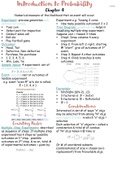Introduction to Probability
Chapter 4
Numerical measure of the likelihood that an event will occur.
Experiment: process generates well- Experiment e.g: Tossing 2 coins
defined outcomes. ▪ How many possible outcomes? 2 x 2
▪ Toss coin Tree Diagram: graphical rep helps in
▪ Select part for inspection visualizing multiple-step experiment.
▪ Conduct sales call Suppose coin = tossed 3 times
▪ Roll die ▪ Step1: Draw columns 4 every
▪ Play football game experiment.
Outcomes: ▪ Step 2: From left 2 right, starting
▪ Head, Tail @ “start”, give all outcomes of 1st
▪ Defective, Non-defective event.
▪ Purchase, No-purchase ▪ Step 3: Repeat 4 other outcomes.
▪ 1, 2, 3, 4, 5, 6 ▪ Step 4: Climb branches & note
▪ Win, Lose, tie outcomes.
Sample Space: 4 experiment: set of
all experimental outcomes.
Event: outcome/set of outcomes of
random experiment.
e.g. event “even #” w/e die is rolled:
E = { 2, 4, 6 }
Factorials:
▪ N!=(N)(N-1)(N-2)….(1)
▪ 3 factorial is: 3! = 3x2x1
▪ 5 factorial is: 5! = 5x4x3x2x1
▪ 0! = 1
Combinations
Interested in det # of ways ”n” objs
may be selected from among ”N” objs
w/o regard 2 order in which “n” objs =
selected.
Counting Rules Each selection of ”n” objects = called a
Multiple-Step Experiments: described combination & total # of combos
as sequence of steps. If multiple-step of ”N” objs taken n @ time is
experiment has k steps w/ possible
outcomes on 1st step, possible
outcomes on 2nd step, & so on, total #
of experimental outcomes = given by: Or # of unordered subsets
(combinations) of size n chosen (w/o
replacement) from N available objs.




